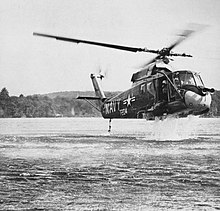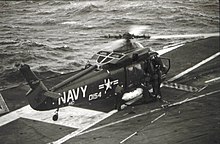
The Sikorsky SH-3 Sea King is an American twin-engined anti-submarine warfare (ASW) helicopter designed and built by Sikorsky Aircraft. A landmark design, it was one of the first ASW rotorcraft to use turboshaft engines.

The Sikorsky SH-60/MH-60 Seahawk is a twin turboshaft engine, multi-mission United States Navy helicopter based on the United States Army UH-60 Black Hawk and a member of the Sikorsky S-70 family. The most significant modifications are the folding main rotor blades and a hinged tail to reduce its footprint aboard ships.
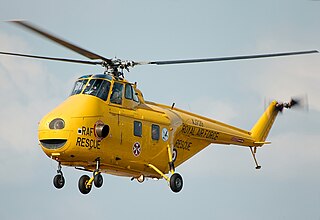
The Westland Whirlwind helicopter was a British licence-built version of the U.S. Sikorsky S-55/H-19 Chickasaw. It primarily served with the Royal Navy's Fleet Air Arm in anti-submarine and search and rescue roles. It was also exported to other countries, and the Whirlwind was succeeded by the turbine powered Westland Wessex which was developed from the H-19/Whirlwind. The helicopter was made in many variants using a variety of radial (piston) and turbine engines.
Kaman Corporation is an American aerospace company, with headquarters in Bloomfield, Connecticut. It was founded in 1945 by Charles Kaman. During the first ten years the company operated exclusively as a designer and manufacturer of several helicopters that set world records and achieved many aviation firsts.

The Westland Wasp is a small 1960s British turbine-powered, shipboard anti-submarine helicopter. Produced by Westland Helicopters, it came from the same Saunders-Roe P.531 programme as the British Army Westland Scout, and is based on the earlier piston-engined Saunders-Roe Skeeter. It fulfilled the requirement of the Royal Navy for a helicopter small enough to land on the deck of a frigate and carry a useful load of two homing torpedoes.

The EurocopterAS565 Panther is the military version of the Eurocopter AS365 Dauphin medium-weight multi-purpose twin-engine helicopter. The Panther is used for a wide range of military roles, including combat assault, fire support, anti-submarine warfare, anti-surface warfare, search and rescue, and medical evacuation.

The Sikorsky H-19 Chickasaw is a multi-purpose piston engined helicopter that was used by the United States Army and United States Air Force. It was also license-built by Westland Aircraft as the Westland Whirlwind in the United Kingdom. United States Navy and United States Coast Guard models were designated HO4S, while those of the U.S. Marine Corps were designated HRS. In 1962, the U.S. Navy, U.S. Coast Guard and U.S. Marine Corps versions were all redesignated as H-19s like their U.S. Army and U.S. Air Force counterparts.

The Sikorsky CH-124 Sea King is a twin-engined anti-submarine warfare (ASW) helicopter designed for shipboard use by Canadian naval forces, based on the US Navy's SH-3 Sea King. Most CH-124s were assembled in Quebec by United Aircraft of Canada. The CH-124 served with the Royal Canadian Navy (RCN) and Canadian Armed Forces from 1963 to 2018.

The Piasecki H-21 Workhorse/Shawnee is an American helicopter, the fourth of a line of tandem rotor helicopters designed and built by Piasecki Helicopter. Commonly called "the flying banana", it was a multi-mission helicopter, capable of being fitted with wheels, skis or floats.

No. 3 Squadron RNZAF is a unit of the Royal New Zealand Air Force (RNZAF). It currently operates NHIndustries NH90 and Agusta A109 helicopters. The squadron was initially formed as a territorial unit of the New Zealand Permanent Air Force in Christchurch in 1930. During World War II, the squadron served in the Pacific, undertaking patrol operations. In the early post war period, the squadron was converted to a Territorial formation flying fixed wing aircraft, but later converted to rotary wing aircraft, and returning to permanent status. Since then, personnel from the squadron have served in the Vietnam War, East Timor, Singapore, the Sinai, and the Solomon Islands.

The Sikorsky H-34 is an American piston-engined military helicopter originally designed by Sikorsky as an anti-submarine warfare (ASW) aircraft for the United States Navy. It has seen extended use when adapted to turbine power by the British licensee as the Westland Wessex and Sikorsky as the later S-58T. This type had a variety of names depending on the role and timing, but included the aforementioned Wessex, Seahorse, Seabat, and Choctaw. Most of the H-34 (S-58) used radial aviation engines, though other powerplants were employed, and the Wessex used predominantly twin gas turbines. Individual versions often had unique names, the type including everything from the U.S. Coast Guard HH-34F Seahorse was used for search and rescue, to the commercial Winnebago Heli-Home, to Canada's CH-126, the USMC it often went by "HUS" after its original designation in that service.

The Sikorsky HH-52 Seaguard was an early amphibious helicopter designed and produced by American helicopter manufacturer Sikorsky Aircraft. It was the first of the company's amphibious rotorcraft to fly.

The Kaman HH-43 Huskie is a helicopter developed and produced by the American rotorcraft manufacturer Kaman Aircraft. It is perhaps most distinctive for its use of twin intermeshing rotors, having been largely designed by the German aeronautical engineer Anton Flettner.

The Patuxent River Naval Air Museum is a museum at Lexington Park, Maryland, first opened in 1978, which preserves and interprets the Naval Air Station Patuxent River history and heritage of advancing US naval aviation technology with artifacts, photographs and film, documents, and related heritage memorabilia from Patuxent River and other naval stations. The museum is dedicated to those who have employed their talents in advancing naval aviation research, development, testing, and evaluation.
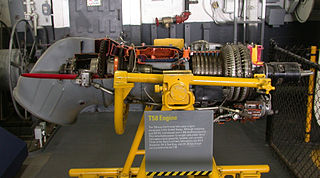
The General Electric T58 is an American turboshaft engine developed for helicopter use. First run in 1955, it remained in production until 1984, by which time some 6,300 units had been built. On July 1, 1959, it became the first turbine engine to gain FAA certification for civil helicopter use. The engine was license-built and further developed by de Havilland in the UK as the Gnome, in the West Germany by Klöckner-Humboldt-Deutz, and also manufactured by Alfa Romeo and the IHI Corporation.
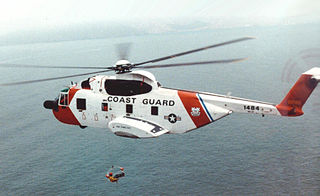
The Sikorsky S-61R is a twin-engine helicopter used in transport or search and rescue roles. A developed version of the S-61/SH-3 Sea King, the S-61R was also built under license by Agusta as the AS-61R. The S-61R served in the United States Air Force as the CH-3C/E Sea King and the HH-3E Jolly Green Giant, and with the United States Coast Guard as the HH-3F, nicknamed "Pelican". This article covers several different variants of this type in different roles, one major difference compared to the S-61 was a rear ramp.

The Bell 47J Ranger is an American single-engine single-rotor light helicopter manufactured by Bell Helicopter. It was an executive variant of the highly successful Bell 47 and was the first helicopter to carry a United States president.

The Bell H-13 Sioux is an American single-engine light helicopter built by Bell Helicopter and manufactured by Westland Aircraft under license for the British military as the Sioux AH.1 and HT.2.

The Kaman SH-2G Super Seasprite is an American ship-based helicopter with anti-submarine, anti-surface threat capability, including over-the-horizon targeting. This aircraft extends and increases shipboard sensor and weapon capabilities against several types of enemy threats, including submarines of all types, surface ships, and patrol craft that may be armed with anti-ship missiles. It was originally developed for the United States Navy in the 1980s as a reengined and updated version of the older Kaman SH-2 Seasprite which had been serving since the 1960s in a variety of versions. The G model was an evolution of the SH-2F, which was an important ASW aircraft for naval vessels that could not manage a larger helicopter. The SH-2G entered service in the 1980s and served until 2001 with the U.S. Navy. It went on to serve in several other Naval forces into the 21st Century and is still in active service in several countries.

The Naval Air Station Wildwood Aviation Museum is an aviation museum located at the Cape May Airport in Lower Township, in Cape May County, New Jersey, United States.

